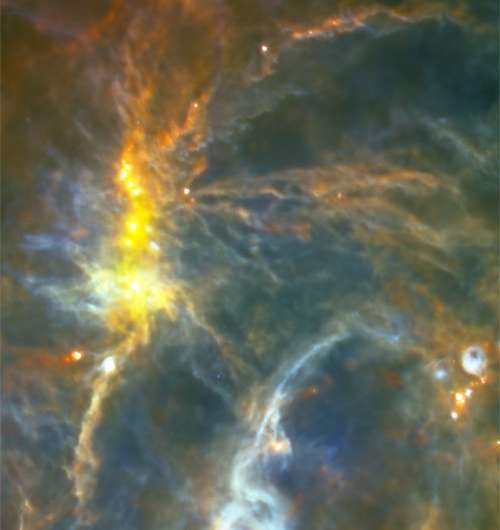Magnetic fields in massive star formation cores

Studies of molecular clouds have revealed that star formation usually occurs in a two-step process. First, supersonic flows compress the clouds into dense filaments light-years long, after which gravity collapses the densest material in the filament into cores. In this scenario, massive cores (each more than about 20 solar masses) preferentially form at intersections where filaments cross, producing sites of clustered star formation. The process sounds reasonable and is expected to be efficient, but the observed rate of star formation in dense gas is only a few percent of the rate expected if the material really were freely collapsing. To solve the problem, astronomers have proposed that magnetic fields support the cores against the collapse induced by self-gravity.
Magnetic fields are difficult to measure and difficult to interpret. CfA astronomers Tao-Chung Ching, Qizhou Zhang, and Josep Girat led a team that used the Submillimeter Array to study six dense cores in a nearby star formation region in Cygnus. They measured the field strengths from the polarization of the millimeter radiation; elongated dust grains are known to be aligned by magnetic fields and to scatter light with a preferred polarization direction. The scientists then correlated the field direction in these cores with the field direction along the filament out of which the cores developed.
The astronomers find that the magnetic field along the filament is well-ordered and parallel to the structure, but at the cores themselves the field direction is much more complex, sometimes parallel and sometimes perpendicular. They conclude that during the formation of the cores the magnetic fields, at least at small scales, become unimportant compared to turbulence and infall. Although the field may play an important role as the filament initially collapses, once the dense cores develop the local kinematics from infall and gravitational effects become more important.
More information: Tao-Chung Ching et al. Magnetic Fields in the Massive Dense Cores of the DR21 Filament: Weakly Magnetized Cores in a Strongly Magnetized Filament, The Astrophysical Journal (2017). DOI: 10.3847/1538-4357/aa65cc
Journal information: Astrophysical Journal
Provided by Harvard-Smithsonian Center for Astrophysics




















